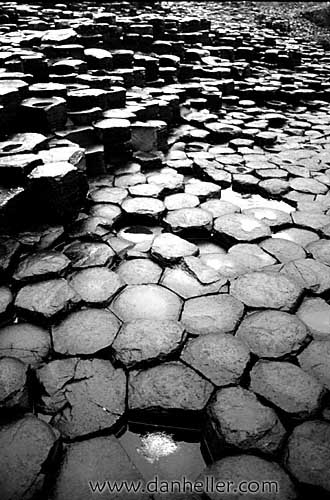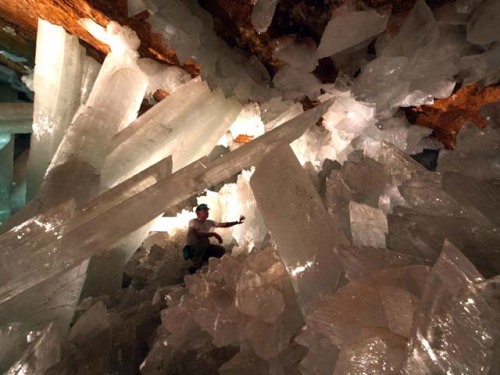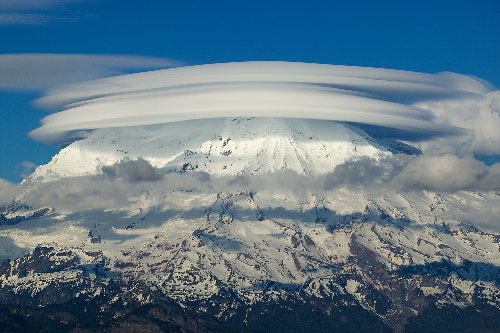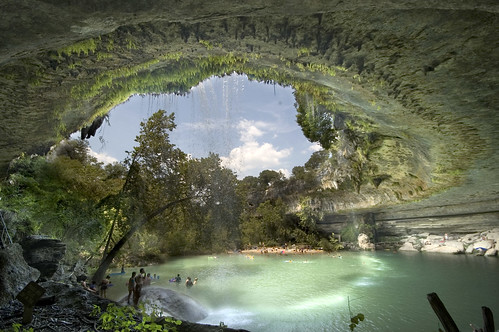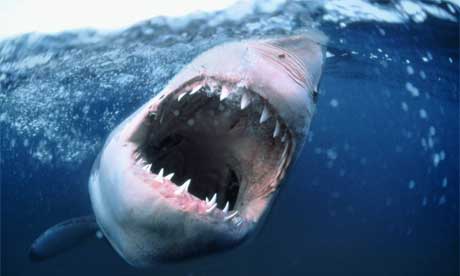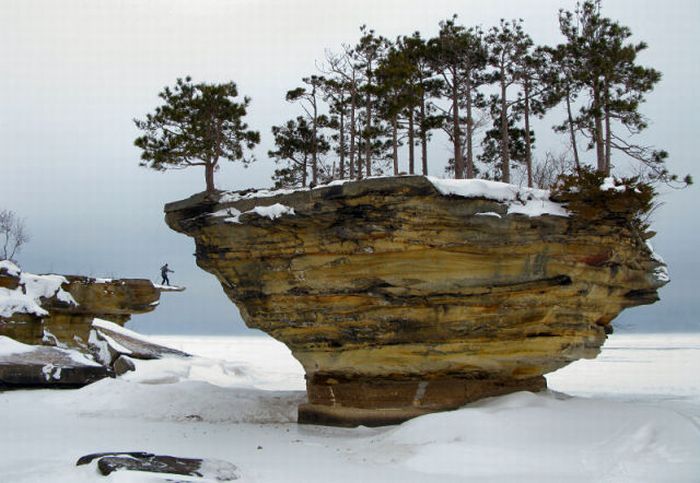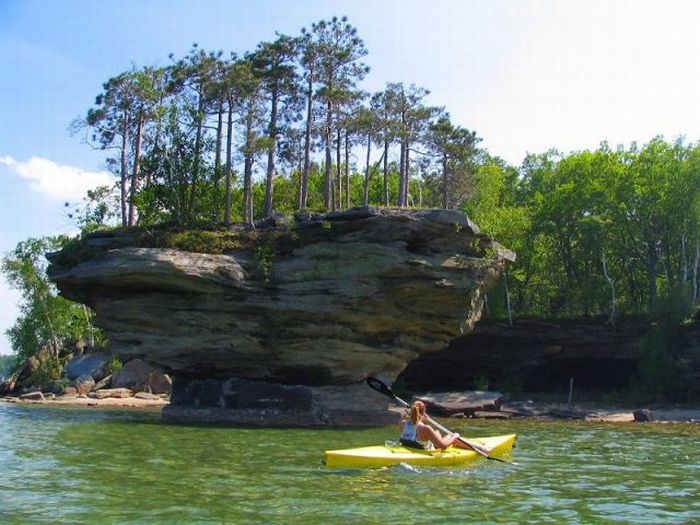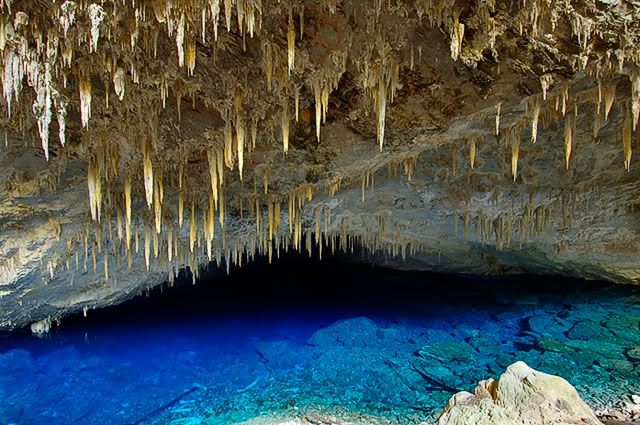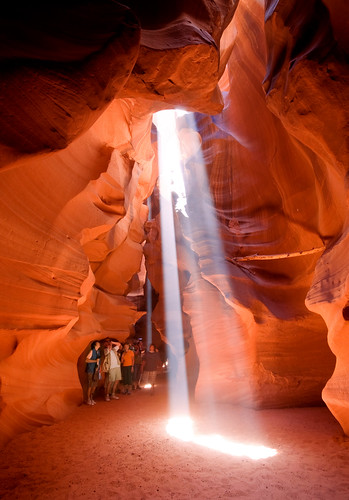Too often we are exposed to the negative aspects of Earth, the over population, the crime, the wars. Wrapped up in our ever growing cities we can easily forget the unparalleled beauty of nature and our infatuation with technology often leads to an alienation from the world around us.
This thread is a reminder that our planet is infinitely more amazing than any piece of technology. When I look at pictures like these I just want to leave everything behind and just explore the world. Hopefully one day...
Enjoy...
US Meteor Crater
Meteor Crater is located in the northern region of the Arizona desert, United States. Approximately 45 miles easy of Flagstaff this massive crater is the handy work of a 50 meter wide meteorite that broke the atmosphere and smashed into our planet sometime around 50, 000 years ago. Although now a desert, this area was once grassy plains dotted with woodlands that ancient beasts like the wholly mammoth and ground sloths would have inhabited.




Great Dune of Pyla
When you think of sand dunes you mostly think of deserts, right? Well there are no deserts in Europe however the Great Dune of Pyla is indeed Europe’s largest sand dune. Located in France, the Great Dune of Pyla is a massive tourist attraction and a favorite spot of para gliders. The dune comes in from the coast with the steep side facing a forest, such a strange sight! Running along 3km of coastline the dune peaks of a height of around 100 meters and covers 500 meters from coast to forest, truly spectacular!




The Door to Hell
The Door to Hell is the only item on this list that has direct human involvement, however the creation of the Door to Hell certainly wasn’t the intended outcome. The Door to Hell is located in Turkmenistan, close to the town of Darvaza. The name ‘Door to Hell’ comes from the fact that this hole has been burning for over 35 years without stopping! The Door to Hell was initially discovered while drilling for gas deposits but the cavern caved in, took a lot of expensive equipment with it and filled with poisonous gas so it was decided the best course of action would be to burn the gas out – it has still yet to burn out.




Mount Roraima
Mount Roraima is a massive tabletop mountain that is found in Venezuela/Brazil/ Guyana. The side facing Brazil and the side facing Guyana are both vertical cliffs that reach 400 meters in height, whereas the side facing Venezuela is a steep incline and although steep it is accessible. This unique mountain boats a variety of plant life, much of it unique and also creates some of the largest and most spectacular waterfalls in the world.




Sigiriya
Is a giant complex situated in the middle of Sri Lanka, it is roughly 370 meters above sea level and visible in all directions. It contains an ancient fortress, gardens, pools, and a gigantic mirror wall, which was once a polished porcelain type wall that was so reflective the King who ordered its creation could see himself in it.



The lions paws entrance.

Salar de Uyuni, Bolivia
Also known as the worlds largest mirror, the Salar de Uyuni is the worlds largest expansive salt flat (25x the size of the Bonneville Flats in Utah) containing over 60% of the planets lithium reserves. It is hard to tell where the earth ends and where the heavens begin in this massive place that is easily seen from space and where the worlds satellites calibrate themselves. Dotted by volcanoes, natural hot springs, flamingos, multi colored lagoons, and incredible views has had the Salar de Uyuni be described as different planet here on earth. The area was part of a prehistoric lake, underneath the Salar is a lake of brine covered by a solid salt crust several meters thick.




Great Blue Hole
The Great Blue Hole is a large underwater sinkhole off the coast of Belize. It lies near the center of Lighthouse Reef, a small atoll 100 kilometres (62 mi) from the mainland and Belize City. The hole is circular in shape, over 300 metres (984 ft) across and 125 metres (410 ft) deep.[1] It was formed as a limestone cave system during the last glacial period when sea levels were much lower. As the ocean began to rise again, the caves flooded, and the roof collapsed.[2] Believed to be the world’s largest feature of its kind, the Great Blue Hole is part of the larger Belize Barrier Reef Reserve System, a World Heritage Site of the United Nations Educational, Scientific and Cultural Organization (UNESCO).



Bay of Fundy, Canada
The Bay of Fundy is reknown for having the highest tides on the planet (16.2 metres or 53 feet). One hundred billion tonnes of sea water flows in and out of the Bay of Fundy twice daily – more water than the combined flow of all the world’s fresh water rivers. Fundy’s extreme tides create a dynamic and diverse marine ecosystem.
The Bay is reknown for its coastal rock formations, extreme tidal effects (vertical, horizontal, rapids and bores) and sustainable coastal development. It is also a critical international feeding ground for migratory birds, a vibrant habitat for rare and endangered Right whales, one of the world’s most significant plant and animal fossil discovery regions.




Hells of Beppu, Japan
Beppu, located on the Japanese island of Kyushu, is the second largest producer of geothermal water in the world. Described as an apocalyptic place, by writers in the Edo Period, where gruesome scenes of torture through boiling took place. With steam coming out through every available crack, Beppu seems like a city that’s cooking over an open flame. The nine hells are named after 9 geothermal hot-spots, known as jigoku (hell) Named because of their resemblance to the Buddhist vision of hell, each of these nine ponds has its own special feature.




Machu Picchu
Machu Picchu was built around 1450, at the height of the Inca Empire. It was abandoned just over 100 years later, in 1572, as a belated result of the Spanish Conquest. It is likely that most of its inhabitants were wiped out by smallpox before the Spanish conquistadores arrived in the area, and it appears that they were aware of a place called Piccho although there is no record of the Spanish having visited the remote city. The Conquistadors defaced sacred rocks in other locations but they are untouched at Machu Picchu.



Angel Falls
It is the world's highest waterfall, with a height of 1,054 m (3,458 ft) and a plunge of 807 m (2,648 ft). The waterfall drops over the edge of the Auyantepui mountain in the Canaima National Park, a UNESCO World Heritage site in the Gran Sabana region of Bolívar State, Venezuela. The height of the fall is so great that before getting anywhere near the ground, much of the water is evaporated or carried away as a fine mist by the strong wind. The base of the falls feeds into the Kerep River (alternatively known as the Río Gauya), which flows into the Churun River, a tributary of the Carrao River.



Feel free to add on...
This thread is a reminder that our planet is infinitely more amazing than any piece of technology. When I look at pictures like these I just want to leave everything behind and just explore the world. Hopefully one day...
Enjoy...
US Meteor Crater
Meteor Crater is located in the northern region of the Arizona desert, United States. Approximately 45 miles easy of Flagstaff this massive crater is the handy work of a 50 meter wide meteorite that broke the atmosphere and smashed into our planet sometime around 50, 000 years ago. Although now a desert, this area was once grassy plains dotted with woodlands that ancient beasts like the wholly mammoth and ground sloths would have inhabited.




Great Dune of Pyla
When you think of sand dunes you mostly think of deserts, right? Well there are no deserts in Europe however the Great Dune of Pyla is indeed Europe’s largest sand dune. Located in France, the Great Dune of Pyla is a massive tourist attraction and a favorite spot of para gliders. The dune comes in from the coast with the steep side facing a forest, such a strange sight! Running along 3km of coastline the dune peaks of a height of around 100 meters and covers 500 meters from coast to forest, truly spectacular!




The Door to Hell
The Door to Hell is the only item on this list that has direct human involvement, however the creation of the Door to Hell certainly wasn’t the intended outcome. The Door to Hell is located in Turkmenistan, close to the town of Darvaza. The name ‘Door to Hell’ comes from the fact that this hole has been burning for over 35 years without stopping! The Door to Hell was initially discovered while drilling for gas deposits but the cavern caved in, took a lot of expensive equipment with it and filled with poisonous gas so it was decided the best course of action would be to burn the gas out – it has still yet to burn out.




Mount Roraima
Mount Roraima is a massive tabletop mountain that is found in Venezuela/Brazil/ Guyana. The side facing Brazil and the side facing Guyana are both vertical cliffs that reach 400 meters in height, whereas the side facing Venezuela is a steep incline and although steep it is accessible. This unique mountain boats a variety of plant life, much of it unique and also creates some of the largest and most spectacular waterfalls in the world.




Sigiriya
Is a giant complex situated in the middle of Sri Lanka, it is roughly 370 meters above sea level and visible in all directions. It contains an ancient fortress, gardens, pools, and a gigantic mirror wall, which was once a polished porcelain type wall that was so reflective the King who ordered its creation could see himself in it.



The lions paws entrance.

Salar de Uyuni, Bolivia
Also known as the worlds largest mirror, the Salar de Uyuni is the worlds largest expansive salt flat (25x the size of the Bonneville Flats in Utah) containing over 60% of the planets lithium reserves. It is hard to tell where the earth ends and where the heavens begin in this massive place that is easily seen from space and where the worlds satellites calibrate themselves. Dotted by volcanoes, natural hot springs, flamingos, multi colored lagoons, and incredible views has had the Salar de Uyuni be described as different planet here on earth. The area was part of a prehistoric lake, underneath the Salar is a lake of brine covered by a solid salt crust several meters thick.




Great Blue Hole
The Great Blue Hole is a large underwater sinkhole off the coast of Belize. It lies near the center of Lighthouse Reef, a small atoll 100 kilometres (62 mi) from the mainland and Belize City. The hole is circular in shape, over 300 metres (984 ft) across and 125 metres (410 ft) deep.[1] It was formed as a limestone cave system during the last glacial period when sea levels were much lower. As the ocean began to rise again, the caves flooded, and the roof collapsed.[2] Believed to be the world’s largest feature of its kind, the Great Blue Hole is part of the larger Belize Barrier Reef Reserve System, a World Heritage Site of the United Nations Educational, Scientific and Cultural Organization (UNESCO).



Bay of Fundy, Canada
The Bay of Fundy is reknown for having the highest tides on the planet (16.2 metres or 53 feet). One hundred billion tonnes of sea water flows in and out of the Bay of Fundy twice daily – more water than the combined flow of all the world’s fresh water rivers. Fundy’s extreme tides create a dynamic and diverse marine ecosystem.
The Bay is reknown for its coastal rock formations, extreme tidal effects (vertical, horizontal, rapids and bores) and sustainable coastal development. It is also a critical international feeding ground for migratory birds, a vibrant habitat for rare and endangered Right whales, one of the world’s most significant plant and animal fossil discovery regions.




Hells of Beppu, Japan
Beppu, located on the Japanese island of Kyushu, is the second largest producer of geothermal water in the world. Described as an apocalyptic place, by writers in the Edo Period, where gruesome scenes of torture through boiling took place. With steam coming out through every available crack, Beppu seems like a city that’s cooking over an open flame. The nine hells are named after 9 geothermal hot-spots, known as jigoku (hell) Named because of their resemblance to the Buddhist vision of hell, each of these nine ponds has its own special feature.




Machu Picchu
Machu Picchu was built around 1450, at the height of the Inca Empire. It was abandoned just over 100 years later, in 1572, as a belated result of the Spanish Conquest. It is likely that most of its inhabitants were wiped out by smallpox before the Spanish conquistadores arrived in the area, and it appears that they were aware of a place called Piccho although there is no record of the Spanish having visited the remote city. The Conquistadors defaced sacred rocks in other locations but they are untouched at Machu Picchu.



Angel Falls
It is the world's highest waterfall, with a height of 1,054 m (3,458 ft) and a plunge of 807 m (2,648 ft). The waterfall drops over the edge of the Auyantepui mountain in the Canaima National Park, a UNESCO World Heritage site in the Gran Sabana region of Bolívar State, Venezuela. The height of the fall is so great that before getting anywhere near the ground, much of the water is evaporated or carried away as a fine mist by the strong wind. The base of the falls feeds into the Kerep River (alternatively known as the Río Gauya), which flows into the Churun River, a tributary of the Carrao River.



Feel free to add on...

